Focal Species: Northern Flicker (Colaptes auratus)
by Josh Lane, Kamana Naturalist Training Program Graduate
& 8 Shields Holistic Tracking Mentor
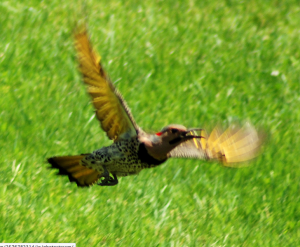 |
| “Yellow-shafted Flicker Takes Flight” by Bob MacInnes, Flickr, CCBY 2.0 Attribute Only Photo License |
I first started intentionally learning about birds and bird language as a teenager. Often while exploring the edges of the northern hardwood forests of New England, the air would explode with a loud, terse “wik-wik-wik-wik-wik-wik. . .” cry. The call was insistent and would always stop me in my tracks.
Frequently, I would try to find the elusive source of the sound, scanning the foliage to no avail. The bird would remain hidden, and the mystery lingered. Only later did I find this to be a trademark sound of the Northern Flicker, a uniquely marked bird with bright gilded wings. Their western counterparts have red-tinted flight and tail feathers, and both varieties have a noticeable white rump patch above the tail. Male flickers have either black or red “mustache” malar markings (yellow-shafted and red-shafted varieties, respectively). Both sexes sport black crescent breast-bands, spotted bellies and barred backs. All in all, the flicker is a visually distinctive bird and a dependable teacher for us in the art of learning bird language.
These days, I have learned to listen for the flicker’s sharp “Clear!!!” calls in conjunction with the “Teek! Teek tut tut tut!” alarms of the American robin, the combination of which often alerts one to the presence of a hunting Cooper’s hawk. The two birds seem to maintain a constant chess game with the accipiter, striving to keep a safe distance and alarming whenever they detect the swift predator changing position. Listen for these paired flicker and robin calls, and then look for sudden bird plows in the distance as the flying accipiter pushes forward a wake of escaping prey.
These kinds of discoveries, such as the relationship of the hawk and the flicker, often arise when a group of people consistently sit and observe bird language together in the same place, over and over. Patterns like this are playing out on the landscape every day, waiting for us to tune into them. It helps to have more than one pair of eyes and ears spread across the landscape – one person may hear an alarm call, and another may actually see what caused it. Together the group sees a larger story that would be difficult or impossible for a lone observer to piece together. This concept is the basis for our yearly 8 Shields California Bird Language Intensive.
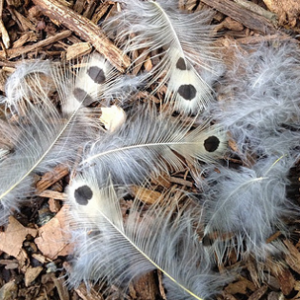 |
| “Feathers, New York Botanical Garden” by Kristine Paulus, Flickr CCBY 2.0Attribute Only Photo License |
Despite being of the woodpecker ilk, flickers spend a fair bit of time on the ground gleaning ants, which are a favored food. It is always a treat to come across the unique tracks of this species – look for them near ant mounds on sandy trails.
Unlike many species that have three toes forward and one toe back on each foot, the flicker leaves a “zygodactyl” k-shaped track caused by two toes pointing forward, and the other two toes pointing backward on each foot. It is thought that this toe arrangement gives woodpeckers a better grip on tree bark, where they spend much of their time foraging for insect larvae.
Spend some time getting to know the flickers in your area, and they will become a dependable bird language teacher for the rest of your life.
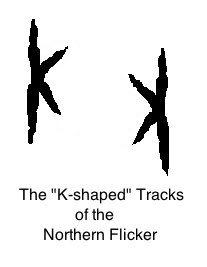 Bird Language Intensive – Early Bird Registration Open Now Through Feb 21st!
Bird Language Intensive – Early Bird Registration Open Now Through Feb 21st!
Join the 8 Shields team from March 31 to April 6 for our popular Bird Language Weeklong Intensive at Green Oaks Creek Ranch in Pescadero, California. Immerse in a village of mentors and learners while exploring the voices of the birds. Learn the patterns of bird behavior and the sounds, movements and postures that can warn them (and us) of distant danger on the wing or on foot.
Learn how to tell the approach of sneaking cats, hunting coyotes and even how to find the hidden daytime roosts of owls, all through the voices of the birds. Join us on the beautiful California coast for this amazing week; this intensive is suitable both for those new to birding, and for those who have been exploring it for awhile and want to go deeper. Family options are available. Learn More & Register on the 8 Shields website. . .
About the Author:
 Josh Lane is an avid wildlife tracker and bird language observer. He contributed to the “How to Learn Bird Language” section of the book, What the Robin Knows, and developed the Backyard Bird Language online course. Josh is a nature connection mentor with 8 Shields in Northern California, and has shared bird language practices at events around North America, including the 2013 National Audubon Conference.
Josh Lane is an avid wildlife tracker and bird language observer. He contributed to the “How to Learn Bird Language” section of the book, What the Robin Knows, and developed the Backyard Bird Language online course. Josh is a nature connection mentor with 8 Shields in Northern California, and has shared bird language practices at events around North America, including the 2013 National Audubon Conference.
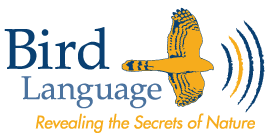
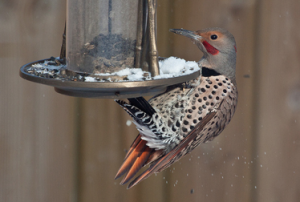
Thank you for this article. The red-shafter flicker is one of my favorite bird friends here in North Idaho. I have had many encounters and also listen to their voice often. Once I had an experience of seven flickers in one place between a chokecherry tree and a power pole and think they must have been a single family with the juvenile fledglings.
Anyway, I can’t make your course, but have enjoyed the emails from Jon as part of 8 Shields.
Best to you for a rich experience with a full complement of participants.
Jane
Love this article – thanks Josh!
I like the idea of focusing on one species at a time. Also, I gleaned an inspiration about setting up a small group locally to practice bird language in one place over time. Quite a harvest for one short article 🙂 – so, again – thanks!
I would happily read and share more such articles!
Craig
Recently at our bird language club sit, we had a wonderful example of the Flicker/cooper’s hawk relationship. During one of the periods, Phil reported hearing the flicker “clear” call and then saw it sentinel towards the west. Moments later it flew west towards the area of disturbance. Meanwhile to the west in the same period, Brian reported having a CA Quail come flying right over his head followed closely behind by a cooper’s hawk. The quail barely made it to cover and the hawk had to veer off at the last moment.
Great story of bird language in action! Those kinds of observations really begin to add up over time, and it will be interesting to see what patterns will be revealed after a while in that place. Thanks for sharing and glad to hear the bird language club is happening!